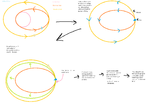Difference between revisions of "Tutorial: Advanced Orbiting/zh-cn"
SlayerGames (talk | contribs) m (Moved to /zh-cn category) |
|||
| Line 22: | Line 22: | ||
飞向其它天体的第一步就是把目前运行的轨道平面与目标轨道平面对齐。 | 飞向其它天体的第一步就是把目前运行的轨道平面与目标轨道平面对齐。 | ||
| − | + | 下一步是找到轨道的支点,下一步是在你的轨道上找到交点,当顺时针或逆时针转动时(视角为相机>飞船>被摄物体),将使它与另一个轨道对齐。(?支点是啥东西) | |
| − | + | 随后,找到飞船的轨道法向,向法向加速会让轨道顺时针旋转;反法向加速将使轨道逆时针旋转。这可能需要几次加速来完善你的轨道,但这将使你能够匹配另一个轨道平面(轨道倾角)。 | |
| − | + | 如果你的轨道是圆形的,那就更容易实现,主要是因为你可以在地图视图中更容易地排好轨道。 | |
| − | == | + | == 轨道同步化 == |
| − | + | [正在编辑] | |
=== The Exley Maneuver === | === The Exley Maneuver === | ||
| Line 35: | Line 35: | ||
[[File:Orbit_Synchronization_how_to.png|thumb|150px|A demonstration using a target planet with an orbit outside your starting planet's orbit.]] | [[File:Orbit_Synchronization_how_to.png|thumb|150px|A demonstration using a target planet with an orbit outside your starting planet's orbit.]] | ||
| − | + | 为了轻松地与目标行星的影响范围相遇,你将需要在转移轨道的近地点或远地点进行几次点火。 | |
| − | ==== | + | ==== 你原轨道之外的行星 ==== |
| − | + | 如果你要与一个轨道在你的起始轨道之外的行星相遇,创造一个转移轨道,使你的远地点尽可能地接近你的目标行星的轨道。 | |
| − | + | 接下来,做几个转移轨道,直到当你到达你的远地点时,目标行星稍微在你前面一点点。沿着你的速度矢量顺向方向开始加速,直到你看到你的轨道在你的远地点附近与目标行星的轨道相交几分之一秒为止。如果你冲过头了,只需转过身,逆着你的速度方向点火,直到再次看到交叉轨道。如果你的转移轨道超过了行星的轨道,那么你就走得太远了,要么错过了交叉轨道,要么没有足够接近目标轨道的远地点,无法受到行星重力。 | |
| − | ==== | + | ==== 你原始轨道内的行星 ==== |
| − | + | 如果你与一个轨道在你的起始轨道内的行星相遇,创造一个转移轨道,使你的近地点尽可能地接近目标行星的轨道。 | |
| − | + | 接下来,做几个轨道,直到目标行星在你到达你的近地点时稍稍落后于你。开始在与你的速度相反的方向燃烧,直到你看到你的轨道在你的近地点附近与目标行星的轨道相交几分之一秒为止。如果你冲过头了,只需转过身来,按照你的速度方向燃烧,直到再次看到交叉轨道。如果你的转移轨道进入了行星的轨道,那么你就走得太远了,要么错过了交叉轨道,要么没有足够接近目标轨道的近地点,无法受到行星影响圈的影响。 | |
| − | ==== | + | ==== 最后==== |
| − | + | 一旦你进入交叉轨道,逆着你的速度方向燃烧,直到轨道绕过你的目标行星。 | |
| − | |||
| − | |||
| + | 祝您好运! | ||
| + | [[User:Dannnnnny|Dannnnnny]] ([[User talk:Dannnnnny|talk]]) 03:02, 18 June 2021 (UTC) | ||
[[Category:Tutorials/zh-cn]] | [[Category:Tutorials/zh-cn]] | ||
{{stub}} | {{stub}} | ||
Revision as of 03:02, 18 June 2021
Contents
霍曼转移
在轨道近拱点发动机点火正向推进(位于正圆轨道则可以在任意时刻进行),直到把轨道远拱点调整到期望高度。
然后,当到达新的轨道远拱点时,再次进行正向推进,把轨道近拱点调整到期望的高度。
以此类推,在相应拱点进行反向推进则可以降低轨道高度。
双椭圆转移
在某些情况下,相比霍曼转移,双椭圆转移更为经济(但需要的时间相对较长)。
首先,正向推进把轨道改变为椭圆轨道。
在轨道远拱点进行正向推进,直到轨道近拱点上升到达期望的轨道高度。
在到达轨道近拱点时,进行反向推进,直到轨道恢复正圆轨道。
在相应点进行反向推进可以降低轨道高度。这样就可以帮助你利用气动刹车来降低轨道高度。
轨道平面对齐
飞向其它天体的第一步就是把目前运行的轨道平面与目标轨道平面对齐。
下一步是找到轨道的支点,下一步是在你的轨道上找到交点,当顺时针或逆时针转动时(视角为相机>飞船>被摄物体),将使它与另一个轨道对齐。(?支点是啥东西)
随后,找到飞船的轨道法向,向法向加速会让轨道顺时针旋转;反法向加速将使轨道逆时针旋转。这可能需要几次加速来完善你的轨道,但这将使你能够匹配另一个轨道平面(轨道倾角)。
如果你的轨道是圆形的,那就更容易实现,主要是因为你可以在地图视图中更容易地排好轨道。
轨道同步化
[正在编辑]
The Exley Maneuver
(As of 0.17.1)
为了轻松地与目标行星的影响范围相遇,你将需要在转移轨道的近地点或远地点进行几次点火。
你原轨道之外的行星
如果你要与一个轨道在你的起始轨道之外的行星相遇,创造一个转移轨道,使你的远地点尽可能地接近你的目标行星的轨道。
接下来,做几个转移轨道,直到当你到达你的远地点时,目标行星稍微在你前面一点点。沿着你的速度矢量顺向方向开始加速,直到你看到你的轨道在你的远地点附近与目标行星的轨道相交几分之一秒为止。如果你冲过头了,只需转过身,逆着你的速度方向点火,直到再次看到交叉轨道。如果你的转移轨道超过了行星的轨道,那么你就走得太远了,要么错过了交叉轨道,要么没有足够接近目标轨道的远地点,无法受到行星重力。
你原始轨道内的行星
如果你与一个轨道在你的起始轨道内的行星相遇,创造一个转移轨道,使你的近地点尽可能地接近目标行星的轨道。
接下来,做几个轨道,直到目标行星在你到达你的近地点时稍稍落后于你。开始在与你的速度相反的方向燃烧,直到你看到你的轨道在你的近地点附近与目标行星的轨道相交几分之一秒为止。如果你冲过头了,只需转过身来,按照你的速度方向燃烧,直到再次看到交叉轨道。如果你的转移轨道进入了行星的轨道,那么你就走得太远了,要么错过了交叉轨道,要么没有足够接近目标轨道的近地点,无法受到行星影响圈的影响。
最后
一旦你进入交叉轨道,逆着你的速度方向燃烧,直到轨道绕过你的目标行星。
祝您好运!
Dannnnnny (talk) 03:02, 18 June 2021 (UTC)
